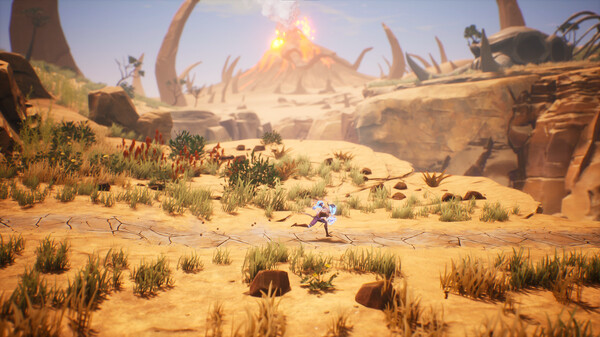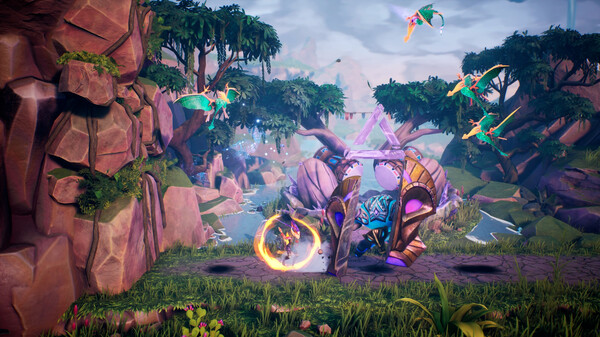I have completed the game on the Balanced difficulty with all achievements in 9.5 hours offline. Tales of Kenzera: Zau is a platformer game with Metroidvania elements in a fantasy setting. There is a short intro in a futuristic setting where the main protagonist, Zuberu, reads a story written by his late father about a young shaman, Zau, whose father had passed away and so this shaman made a deal with the god of death to bring him back. As one can guess, the main focus is on dealing with grief. It is a decent platformer with a touching and well-paced story and functional traversal and combat, with the more challenging aspects of both being optional, though the controls are a bit stiff and the game suffers greatly from the 3D graphics. Recommended on sale. A lot of the traversal abilities are available from the start, such as double jump and air dash, which affects the difficulty of the platforming sequences - these abilities are expected to be actively used from the start. As the story progresses, more traversal and combat abilities are unlocked, though the increased complexity is reasonably engaging. The game features the insta-killing spikes early as well, continuing with the insta-killing lava and the insta-killing chasms, but dying to them results in returning to the last safe platform, which is usually very close, so the progression is steady. As both the typically late-game traversal abilities and the main weapons (the melee Sun Mask and the ranged Moon Mask) are unlocked from the start, while the new ones allow more unusual but limited interactions with the environment (e.g. freezing waterfalls or activating specific switches), the mechanical character progression feels odd - the new abilities do not make traversing the previously-visited areas easier, but provide the only way to progress in the increasingly-complex new locations, while the weapons are just there and their base movesets do not change (the special moves do become stronger). The areas feel more linear than I would expect from a Metroidvania, even counting the “Find 2 keys” mandatory objectives in each of them, while the tight timing for some platforming sequences and the abundance of the insta-killing spikes make it closer to the general platformers. The camera pans and zooms out automatically and very slowly which quite often resulted in me accidentally falling onto the spikes. The important collectibles (background lore, health upgrades, spirit energy upgrades) and challenges are marked on the map (or can be seen as clearly undiscovered areas) and the less important ones can be found by looking at any fork on the critical path. There are also optional dedicated platforming challengings, usually rewarding with trinkets (passive abilities), and fewer combat ones rewarding with trinket slots and energy upgrades. The experience points gained in combat and exploration can be spent in 2 skill trees, which improve both the regular attacks and the energy-consuming ones. There is a fast travel system available early, which significantly reduces backtracking. It should be noted that the abilities that require aiming do not provide a slow-motion effect and the timed sequences are unaffected by the difficulty settings (confirmed by the developers). While there are unlockable shortcuts (with “Shortcut unlocked” messages on the screen), I do not remember ever using them - there is no need to backtrack if one explores thoroughly on the first run and the fast travel system covers the travel between the possible points of interest (e.g. the platforming or combat challenges). The basic combat consists of two masks, with their own abilities and movesets, and dodging (the discovered active abilities can be used for combat and can be upgraded as well). The controls feel slightly unresponsive and it is hard to see the protagonist due to the post-effects (everything glows). The enemy variety is lower than I would like - there are 2 starting types, which are present throughout the game and 6 more introduced later on. While the regular enemies do not respawn (which leads me to believe that the areas were not meant to be revisited), there are replayable combat gauntlets. There is 1 healing ability and it draws from the same energy pool as the active combat abilities, which is restored upon attacking enemies. The most challenging aspect of the arena battles, where it is not possible to proceed without defeating all foes (story-wise, putting the spirits to rest), is that some enemy attacks bounce the protagonist, while the arenas are quite rich in the insta-killing spikes. The only time when the foes themselves were a threat was the optional no-hit challenge due to the camera and homing projectiles. A small thing which I find annoying is that there is a mid-game ability (Zawadi’s Hook) that pulls the foes to the protagonist, interrupting them, or the protagonist to the foes, without interruption, so getting hit in the face is the most likely outcome. The issue is that the interruptive pull is bound to the ranged Moon Mask, while the get-hit-in-the-face-yourself option (which also might result in falling into the spikes and having to restart the battle) is bound to the melee Sun Mask. Thus, to make it useful, I had to switch to the Moon Mask exclusively to pull the enemies, then to the Sun Mask to actually hit them. The Sun Mask in general seems to be more powerful than the Moon Mask. There are few bosses, though they are connected to the main story with the path to them explaining their background and how it relates to the protagonist’s struggles and goals. The battles against them are diverse and can include several stages. The game uses 3D graphics with 2D (side-scroller) design. The fully-voiced dialogues use gorgeous static 2D sprites with a lot of different poses and facial expressions for the characters. While the visual style is beautiful, especially the character sprites, the 3D graphics and a lot of post-effects introduce a lot of visual noise and make it harder to see which surfaces are possible to climb if they are not in the middle of the screen. It becomes worse by the late areas where the bright orange Sun Mask is hardly visible on the bright orange sand or the bright orange lava. Although the VA and music are generally pleasant to listen to, ultimately, the 3D graphics and VA are a waste of resources for an essentially 2D game, especially when the 2D assets (e.g. sprites and loading screens) look much better aesthetically and practically (easier to see the platforms and the background), require less energy to run, and space to store. The system requirements are ridiculous for a game in this genre. The controls are partially rebindable (the directional movement controls cannot be bound to the arrow keys and must be chosen from the presets; mouse scroll-up/-down do not work) and 5-button mice are supported. The aim occasionally does not follow the cursor despite the settings and another small thing that annoys me is that the controller settings are above the keyboard and mouse settings for a PC game. There are 3 save slots and the progress is saved automatically, meaning that Windows Explorer is to be used for the save file management (they are located in “C:\Users\ \AppData\Local\Zau\Saved\SaveGames”). I have encountered 1 softlock in early game, which, as the name suggests, would have made the save file unusable, and a few times the protagonist got stuck in walls, but I was able to dash out without restarting. So, save often, save manually. The game has crashed once on the last Shaman Trial (fortunately, the progress was saved and the save was not corrupted) and once at the end of the first stage of the final boss (there I had to run back for a few minutes because it was past the point of no-return). The smaller bugs are physics-related.
Expand the review

























